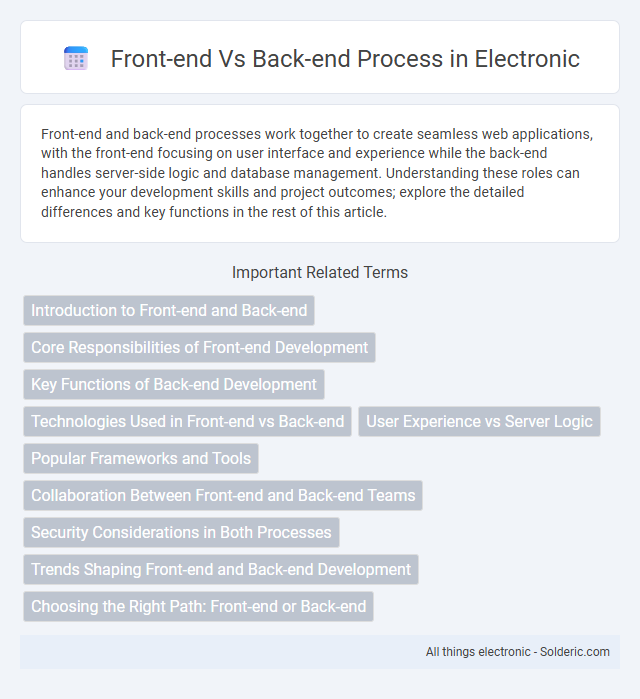Front-end and back-end processes work together to create seamless web applications, with the front-end focusing on user interface and experience while the back-end handles server-side logic and database management. Understanding these roles can enhance your development skills and project outcomes; explore the detailed differences and key functions in the rest of this article.
Comparison Table
| Aspect | Front-end Process | Back-end Process |
|---|---|---|
| Definition | User interface and experience; what users see and interact with | Server-side logic, database management, and application functionality |
| Languages | HTML, CSS, JavaScript, TypeScript | Python, Java, Ruby, PHP, Node.js, .NET |
| Responsibility | Design, layout, responsiveness, client-side validation | Data processing, server setup, API integration, security |
| Tools & Frameworks | React, Angular, Vue.js, Bootstrap | Django, Flask, Express.js, Laravel, Spring |
| Data Handling | Rendering data provided by back-end, user input collection | Database queries, data storage, server-side validation |
| Performance Focus | Load speed, smooth animations, browser compatibility | Server uptime, efficient data processing, scalability |
| Security | Client-side input validation | Authentication, authorization, data encryption, secure APIs |
Introduction to Front-end and Back-end
Front-end development involves creating the visual and interactive elements of a website or application that users engage with directly, utilizing technologies such as HTML, CSS, and JavaScript. Back-end development focuses on server-side logic, databases, and application functionality, often employing languages like Python, Ruby, or Node.js to manage data processing and server communication. Both front-end and back-end processes are crucial for building seamless, dynamic web experiences where front-end interfaces connect to back-end systems for data retrieval and storage.
Core Responsibilities of Front-end Development
Front-end development focuses on creating the user interface and ensuring seamless interaction between users and websites or applications. Your primary responsibilities include designing responsive layouts, implementing visual elements with HTML, CSS, and JavaScript, and optimizing performance for a smooth user experience. Mastery of frameworks like React, Angular, or Vue.js is essential to streamline development and enhance your application's usability.
Key Functions of Back-end Development
Back-end development handles the server-side logic, database interactions, and application integration that ensure seamless functionality behind your website or app. It manages user authentication, data storage, and server communication, enabling secure and efficient processing of requests. Strong back-end systems use programming languages like Python, Java, or Node.js to support dynamic content delivery and maintain overall performance.
Technologies Used in Front-end vs Back-end
Front-end development relies heavily on technologies such as HTML, CSS, and JavaScript frameworks like React, Angular, and Vue.js to create interactive user interfaces. Back-end technologies primarily include server-side languages and frameworks like Node.js, Python with Django or Flask, Ruby on Rails, and databases such as MySQL, MongoDB, or PostgreSQL for data management and server logic. Your choice between front-end and back-end technologies impacts the overall functionality and user experience of web applications.
User Experience vs Server Logic
Front-end development is centered on creating intuitive User Experience by designing interfaces that are visually appealing and easy to navigate, ensuring your interactions feel seamless and responsive. Back-end process focuses on Server Logic, managing data processing, authentication, and communication between the server and database to guarantee reliable performance and security. Efficient coordination between front-end and back-end components is crucial for delivering a cohesive application that meets both usability and functionality standards.
Popular Frameworks and Tools
Popular front-end frameworks include React, Angular, and Vue.js, which enable developers to build dynamic and responsive user interfaces with reusable components. On the back-end, Node.js, Django, and Ruby on Rails provide robust platforms for server-side logic, database interactions, and API development. Tools like Webpack and Babel optimize front-end performance, while Docker and Kubernetes enhance back-end deployment and scalability.
Collaboration Between Front-end and Back-end Teams
Effective collaboration between front-end and back-end teams ensures seamless integration of user interfaces with server-side logic, enhancing overall application performance. Clear communication and shared understanding of APIs, data structures, and workflows allow your development process to be more efficient and reduce bugs. Utilizing tools like version control systems and continuous integration further strengthens team coordination and product quality.
Security Considerations in Both Processes
Front-end security primarily involves safeguarding against client-side threats such as cross-site scripting (XSS) and ensuring secure data input validation to prevent unauthorized access or data manipulation. Back-end security focuses on protecting server-side resources, implementing robust authentication, authorization protocols, and securing databases against SQL injection and data breaches. Both processes require stringent encryption practices, secure API communication, and continuous monitoring to maintain integrity and confidentiality across the entire web application lifecycle.
Trends Shaping Front-end and Back-end Development
Emerging trends in front-end development emphasize JavaScript frameworks like React, Vue.js, and Angular for dynamic user interfaces and enhanced performance. On the back-end, the adoption of cloud-native technologies, microservices architecture, and serverless computing drives scalable and efficient application deployment. Both front-end and back-end development increasingly leverage AI-powered tools and DevOps practices to streamline workflows and improve software quality.
Choosing the Right Path: Front-end or Back-end
Choosing the right path between front-end and back-end development depends on your interests in user interface design or server-side logic. Front-end focuses on HTML, CSS, and JavaScript to create visually appealing, responsive websites, while back-end involves programming languages like Python, Java, or Node.js to manage databases and application functionality. Understanding your preference for creative design or problem-solving with data handling will guide your career choice effectively.
Front-end vs Back-end Process Infographic

 solderic.com
solderic.com